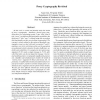91 search results - page 13 / 19 » Immunizing Encryption Schemes from Decryption Errors |
NDSS
2003
IEEE
15 years 3 months ago
2003
IEEE
In this work we revisit and formally study the notion of proxy cryptography. Intuitively, various proxy functions allow two cooperating parties F (the “FBI”) and P (the “pro...
ITNG
2006
IEEE
15 years 3 months ago
2006
IEEE
Informally, Privacy Homomorphism (PH) refers to encryption schemes with a homomorphic property allowing to obtain Ek(a + b) or Ek(a × b) from ciphertexts Ek(a) and Ek(b) without ...
CRYPTO
2008
Springer
14 years 11 months ago
2008
Springer
In this paper we introduce the notion of a Public-Key Encryption Scheme that is also a Locally-Decodable Error-Correcting Code (PKLDC). In particular, we allow any polynomialtime ...
ISQED
2010
IEEE
14 years 11 months ago
2010
IEEE
Recent studies have shown that an attacker can retrieve confidential information from cryptographic hardware (e.g. the secret key) by introducing internal faults. A secure and re...
SPW
2004
Springer
15 years 3 months ago
2004
Springer
This note presents a new way of composing cryptographic primitives which makes some novel combinations possible. For example, one can do threshold decryption using standard block c...

